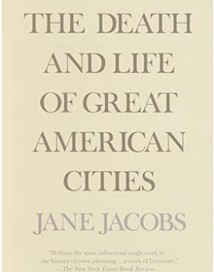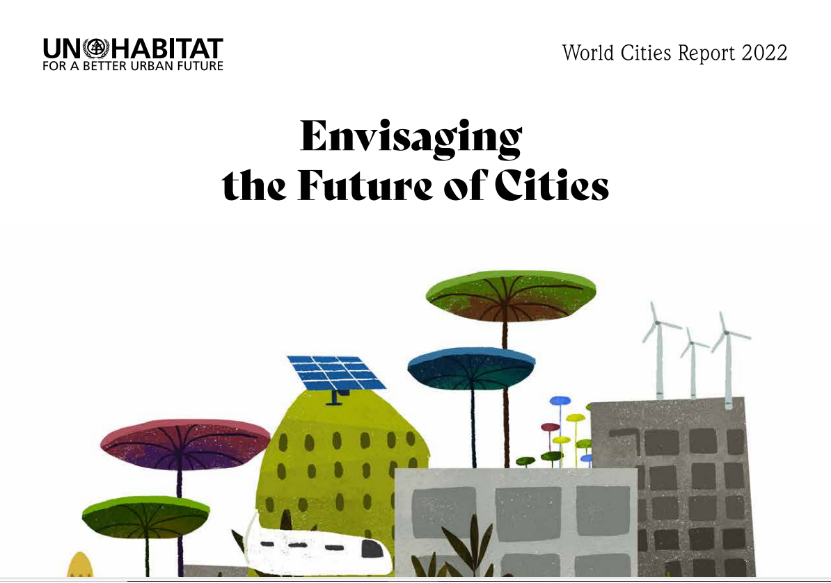Review of Life and Death in Great American Cities
Jiaying Cong
Jane Jacobs was an urbanist and activist whose writings championed a fresh, community-based approach to city building. She had no formal training as a planner, and yet her 1961 treatise, The Death and Life of Great American Cities, introduced ground-breaking ideas about how cities function, evolve and fail. The impact of Jane Jacobs's observation, activism, and writing has led to a 'planning blueprint' for generations of architects, planners, politicians, and activists to practice.
In prose of outstanding immediacy, Jane Jacobs writes about what makes streets safe or unsafe; about what constitutes a neighborhood, and what function it serves within the larger organism of the city; about why some neighborhoods remain impoverished while others regenerate themselves. She writes about the salutary role of funeral parlors and tenement windows, the dangers of too much development money and too little diversity.
Part I: The Character of Cities
The first part of the book focuses on the basic characteristics of cities and the core elements of urban life. The author sees the city as a living organism that grows naturally and has an inherent order that is different from the simple structure and order that humans seek. She argues that city streets, as well as sidewalks, are fundamental to the success of cities. Streets need to serve the three basic purposes of safety, interaction, and socialization of children, and need to be planned and designed to achieve a vibrant and humane urban environment.
Part II: Conditions for urban diversity
The second part focuses mainly on the conditions of urban diversity, which is a key factor in maintaining the vitality and viability of cities. She argues that for a city to produce rich diversity, it must satisfy: (1) the integration of multi-functionality; (2) the shortness of streets; and (3) the diversity of buildings. The author also emphasizes the central role of streets in urban life, arguing that they are the most important organ of the city, not only maintaining its safety, but also facilitating people's interactions and children's growth. The authors explore specific strategies for urban management, including how to save and utilize low-cost residential areas and how diagnostic analyses can complement the conditions that give rise to diversity, such as mixed primary uses, short street segments, and high population densities.
Part III: Forces of Decline and Renewal
This part focuses mainly on urban decline and renewal. In this part, the causes of urban decline are explored in depth and corresponding renewal strategies are proposed. She argues that urban decline is not inevitable, but rather the result of inappropriate planning and redevelopment. She critiques past problems in American urban planning, such as the neglect of low-income residential areas and the over-commercialization of city centers. In Part III, Jacobs discusses the relationship between urban density and diversity, arguing that high density is not the same as crowding, but can stimulate diversity in cities. She points out that the concentration of urban population is a resource, and that the task of urban design should be to improve the quality of life of the urban population and to provide good urban living opportunities.
Part IV: Different Strategies
Part IV focuses mainly on specific strategies and approaches to urban management. In this part, the author proposes new principles for urban planning and construction. She argues that planning should be based on an in-depth understanding of the mechanisms of urban functioning rather than on a simple treatment of superficial phenomena. She emphasizes that urban planning should respect the complexity and natural development of cities and promote healthy urban development through incremental improvements rather than radical social reform programs. She suggests that urban planning should focus on the community level, reject elitism, and emphasize the importance of individual freedom and private property, while respecting market forces and rejecting human intervention in market mechanisms. She advocates advocacy planning, which involves the participation of community residents in the planning process to ensure that the planning program meets the actual needs of the residents. She believes that diversity is a source of urban vitality, and that urban planning should aim to create and maintain such diversity rather than diminish the complexity and richness of cities through the delineation of monofunctional zones.
Overall, Part IV is an in-depth discussion of Jacobs' strategies for urban planning and construction, and her ideas not only had a significant impact on urban planning at the time, but also provided important insights and guidance for later urban planning and construction.
In The Death and Life of Great American Cities, Jane Jacobs not only brought revolutionary ideas to the field of urban planning, but also provided us with a brand-new perspective on urban life.
In her book, Jacobs criticized the popular urban planning models of the time, especially large-scale demolition, and redevelopment projects, which she believed ignored the nature of the city as an organism. She advocated urban planning that was based on careful observation and understanding of existing neighborhoods, emphasizing the safety of streets, the diversity of buildings, and the mix of uses.
Jacobs' ideas challenged modern urban planning, especially in dealing with urban renewal and community development. Her ideas have prompted planners to reconsider the social function of urban spaces and how design can enhance community cohesion and vitality.
As readers, we can look to our personal experience of living in the city to consider how Jacobs' ideas resonate with our reality. For example, residents living in large residential areas may appreciate the importance of community intimacy and street life that Jacobs emphasizes. And as China's urbanization continues, residents of all cities can appreciate the importance of streets and neighborhoods from a variety of perspectives.
“Death and life” is more than just existence or non-existence in the traditional sense. Changes in layout, correct planning or not, can affect the future development of a city and ultimately lead to its death or not. Is it possible to revitalize a large city after its “demise” and what is the role of human beings in the city? These are the questions this book seeks to answer, and they are the questions we need to answer. During the period when the real estate industry was booming, and all places were striving to put up high-rise buildings, many high-rise buildings broke through the ground and rose up from the ground. Matching facilities are brand new but lack vigor. In recent years, when many buildings are left to rot, and then look at those new towns, it seems even more desolate. Daytime is good, after all, there is a bright and shiny appearance as a package. But at night, the building, only one or two windows through the light, is really a bit scary. The old town is not perfect. Will there be more new urban slums in the future? These problems are not unique to us; urbanization is accompanied by problems that many countries have experienced. Perhaps we can find answers from them. And “The Death and Life of Great American Cities” is one such work.
This work goes more into attacking the problems behind planning. The first thing that needs to be made clear is that this book does not consider planning to be sinful, and the authors support the promotion of interactive planning rather than theoretical planning. Therefore, the problems identified, and solutions proposed in the book are not found in the theoretical literature, nor are they designed problems, but are areas that the author has experienced and interviewed; and the final solutions are also based on the improvement or development of existing cases. It is because of this overly pro-people viewpoint and methodology coupled with the author's non-scientific status that her finger-pointing at big-city planning was and still is subject to a lot of ridicule and criticism. But just as there are economists per capita in the food market, and a long time has passed, the first-hand experience gained by the person at the center of the interactive experience is often more important. Therefore, the ideas and solutions mentioned by the authors of this book may not be expressed with enough rigor and worded with enough caution, but they are helpful in solving the problems.
The book mentions the segmentation effect of “streets that are too long” and the contrasting areas of light and dark, such as the interaction between building terraces and peripheral passages, as manifestations of the city's rigidity in concentrating its vitality at a single point. The diminishing number of street-level stores and the indifference brought about by high mobility are signs of the deactivation caused by the increasing distance between people. Modern cities don't advocate a society of acquaintances, but passing the convenience store on the corner every day still gives a sense of familiarity. Therefore, how to find a way to revitalize the city within the concrete and steel of the city is the key to the transformation between “death and life”.
It is centered around the problems previously identified and the solutions already mentioned in fragments. Whether it is the case of planning for specific districts or the idea of administrative setups leading to urban planning, all these elements have one characteristic: the grouping and blocking of the city. In fact, this is not uncommon in our current urban life. Even in some cities, the boundaries are clearly defined, and lights are turned on at different times on both sides of the road in different zones. From this point of view, the problems of the big city cannot be solved in the big city, but need to be partially, block solution. So, what is the point of big cities? If they cannot function as a whole and return one-sidedly to regional autonomy, what should be done with the wholeness of the city. To be more specific, will the district boundaries become new “unregulated” areas. In this way, we still have a lot of problems to solve, at least we must answer the question of how big is the area that can be solved by planning, and where are the reasonable boundaries of the city.
Despite the far-reaching impact of Jacobs' ideas, there are certain limitations to their applicability in different cultural and social contexts. For example, in high-density urban environments, realizing the low-rise, high-density architectural model advocated by Jacobs may face many challenges. The low-rise, high-density architectural models she advocates cannot be directly replicated in China's rapidly urbanizing cities, and the applicability of her recommendations to developing countries with large numbers of people needs to be further debated and verified.
The Death and Life of Great American Cities provides a new framework for understanding and constructing cities. In the face of the challenges of rapid urbanization, Jacobs' ideas remind us that urban planning should focus more on human needs and the vitality of urban space. Future urban planning needs to respect history and culture while innovatively incorporating modern technology and social needs to achieve sustainable and inclusive urban development. Therefore, Jane Jacobs' the Death and Life of Great American Cities is a classic that transcends time, which not only changed the trajectory of urban planning, but also inspired us to think deeply about urban life.




